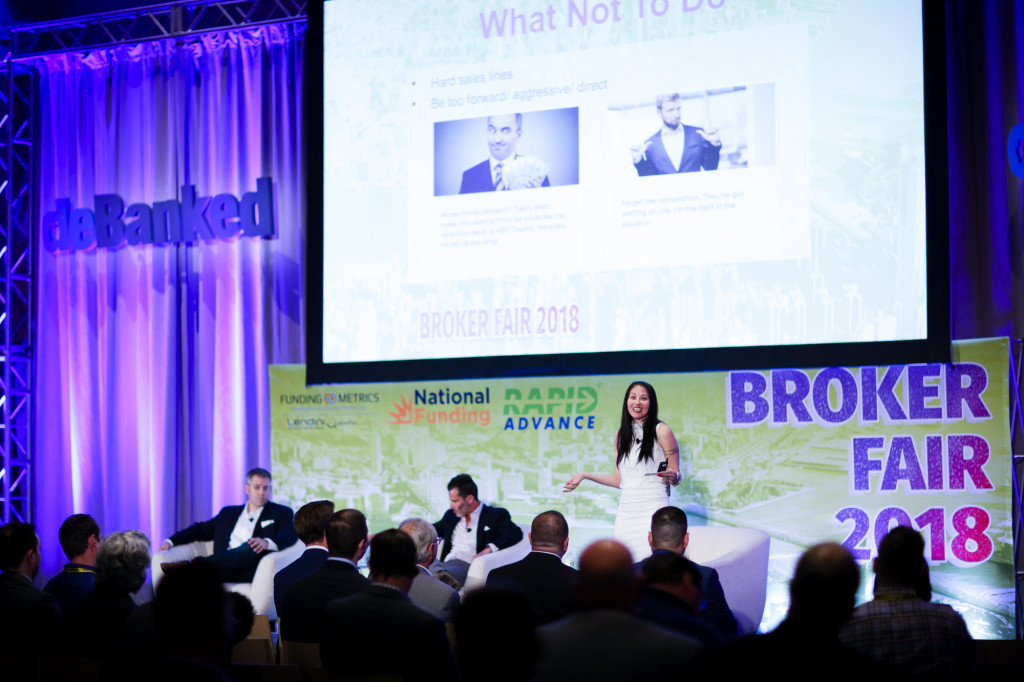marketing
NerdWallet: Still Pressure in SMB Loan Originations
March 2, 2025NerdWallet’s CEO Tim Chen explained during the company’s Q4 earnings call that headwinds across both consumer and SMB lending have not let up.
“We continue to see pressure in SMB loan originations with rates remaining elevated and underwriting remaining tight, while also seeing increased pressure in our renewals portfolio as the 10-year rates reversed course and began to climb,” he said.
NerdWallet originates borrowers through the internet, a significant portion of which comes from organic search traffic. That organic traffic dipped about a year ago after changes to Google’s algorithm but has been recovering over the last two quarters for SMB loans. During the earning’s call, one analyst, Ralph Schackart of William Blair & Company LLC, had a question about the continued reliance on that channel given the rise of competing AI chat assistants.
“I guess as you are sitting here today and sort of operating this business, obviously for a while here, how different do you think these changes are to the business with AI overviews?” Schackart asked. “And some digital buyers are saying that the ads that are generated from Gen-AI are actually performing better than some of the organic results. Just kind of curious, what’s your confidence that this is something you’ll be able to navigate longer term versus your previous history? ”
This was Chen’s response:
“I’ll split it up between kind of the shorter-term stuff we’re seeing and longer-term thoughts. I mean in the near term, there’s two drivers here. Which is, one is more ads and modules on top of the search results. And the other factor is rank. Where in the very recent past, financial institutions and some government websites are winning in some areas where they traditionally haven’t, which as I’ve alluded to in past calls, is a bit of a head scratcher when considering consumer intent.
We do think this period of frenetic testing will eventually stabilize, and when that happens, it should play to our favor. Longer term, I do think that it’s important to look at broader industry trends. First, AI search engines or chatbots, are they taking share from traditional search engines?
I mean from what we can tell, not really. If you look top-down, more people are using search engines than they did last year, but you also see triple-digit growth in AI usage. Which says to me that people are basically just asking more questions that they weren’t asking before. And second, the things like AI overviews, how is that affecting the ecosystem?
So I know we’re not focusing on MUUs operationally, but it’s helpful to understand that if simple questions have simple answers, and if a search engine can serve that up in a faster way that consumers prefer, then that’s good for the ecosystem.
And for us, we’re seeing these features do a really good job of answering simple educational questions, and that’s affecting traffic to some of our noncommercial pages. That has not been the case yet for our monetizing pages, which are fundamentally just a little more complicated.
Like if you need to shop for a mortgage for instance, you really need to go through a marketplace experience. So yes, on balance, we think that this period of frenetic testing will stabilize. We’ve seen a few things like this in the past, and we can grow from there.”
What Works in Marketing Financial Products
November 17, 2021 Social media was at the top of the list for many marketers that deBanked spoke with, but there are certain formulas necessary to make it work, they say.
Social media was at the top of the list for many marketers that deBanked spoke with, but there are certain formulas necessary to make it work, they say.
“It’s coming up with new ways to say ‘we want to fund your deals,’” said Cassandra Lund, Social Media Manager at Lendini, when asked what the hardest part of her job is. Being heavily involved in the marketing campaigns of a large small business funding company, Lund believes social media is a prime place for setting up brand legitimacy.
“[Social media] provides something that even other forms of marketing cannot,” said Lund. “It instantly connects you to your audience and allows them to ask questions right away, either through direct message or as a comment.”
Fintech companies are also strategically using social media to start getting their name out there. Jennifer Marshall, Marketing Manager at fraud and dispute software provider Quavo, praised the power of social media; especially platforms that provide a professional environment for both consumers and businesses.
“We see the most results on LinkedIn,” said Marshall, “from both paid and organic efforts. “LinkedIn can take [businesses] a long way if their marketing team leverages tagging and mentioning [on the platform]. In the early stages of a company, when brand awareness is the top priority, [businesses] should leverage their employees’ LinkedIn networks.”
 While Marshall and Lund are marketing different financial products, they both agree on the inherent value of LinkedIn to their respective companies when it comes to a buttoned-up platform for connections and content.
While Marshall and Lund are marketing different financial products, they both agree on the inherent value of LinkedIn to their respective companies when it comes to a buttoned-up platform for connections and content.
“Just create a Linkedin and Instagram and start posting,” Lund said, when asked how a business could get their foot in the social media door. “You will find people in your industry, potential clients and information about what other businesses in your field are doing. Build out from there, and your business will thank you for it.”
With the opportunity social media provides comes responsibility, and some companies have let simple mistakes hurt the perception of their brand. Lund and Marshall both believe that a misguided or typo-littered social media presence can do a company more harm than good.
“Spelling errors and bad graphics, I see these [errors] a lot on social media as it becomes more and more important to small businesses,” said Lund. “There is nothing more important on social media than a first impression, and a spelling error or hugely pixelated photos is a major deterrent.”
Marshall stressed that companies not let “B2B vs B2C” marketing practices dictate their social media efforts. “In the end, you should want to reach people where they work and where they play. Once you understand that, the value of social media to all financial companies is crystal clear.”
 With new members of the work force living most of their lives ingrained in social media, it appears its value in the business world is exponential. “The younger generations have used it for years, or since being born, and it’s not going anywhere in the near future,” said Lund. “Finding new clients, new customers and like-minded business professionals on [social media] helps build your brand and stake a claim in the industry. Anyone that doesn’t think social media is important in business in general is missing out.”
With new members of the work force living most of their lives ingrained in social media, it appears its value in the business world is exponential. “The younger generations have used it for years, or since being born, and it’s not going anywhere in the near future,” said Lund. “Finding new clients, new customers and like-minded business professionals on [social media] helps build your brand and stake a claim in the industry. Anyone that doesn’t think social media is important in business in general is missing out.”
Marketing financial products, especially new or alternative fintech solutions can be difficult, however. When asked about how to market a financial product, Francesca Ligouri, Lead National Designer at Create with Chess, a national marketing company that works in a variety of industries, spoke about the values of traditional marketing materials on top of social media. She stressed the importance of putting a tangible item that explains your business model in the hands of a potential customer that may not fully understand the product being sold to them.
Ligouri spoke about networking materials, and how sometimes the explanation of a product is best done through tangible imagery.
“It’s about using infographics and icons [to help] create a storyline of what you’re trying to say, while keeping your demographic engaged,” said Ligouri. “Illustrative materials like brochures, folders, and mailers make people want to pick up your collateral and be like ‘oh cool, what is this all about?’ instead of printing a word document of all your info and expecting people to want to read through it.”
Whether it is printed or digital materials, innovation in finance isn’t just about the technology behind the products themselves, but also about how those brands and their products are introduced to potential customers.
Facebook Ads Don’t Work For Finance?
March 29, 2021 In an op-ed by Brittney Holcomb in Leasing News, Holcomb wrote that “when it comes to developing lead generation, social networks are not the answer.”
In an op-ed by Brittney Holcomb in Leasing News, Holcomb wrote that “when it comes to developing lead generation, social networks are not the answer.”
Holcomb breaks down her reasoning, explaining that Likes do not equal leads. It’s worth a read if you have advertised or have thought about advertising on Facebook, but I will respectfully disagree with her on the basis of her arguments.
“People don’t log on to social networks to search for products or services,” she writes, “They use social media to communicate with their friends and family.”
Perhaps so, but there are many different ways in which to approach Facebook advertising, and I say this as someone who has had success advertising in the B2B universe on the platform. Users weren’t searching for my product or service either and I wasn’t advertising for the sake of branding, something I personally do not even consider doing.
You can use social networks like Facebook to convert a lead you almost got or lost. For example, not everybody that comes to your website ends up completing a form and for those that do, fewer yet will end up signing a contract.
What happens is your prospects get distracted, decide to do more research, or get wooed by a competitor. Maybe they just weren’t convinced the timing was right. This is where social network advertising comes into play because you can relay that website visitor data or unclosed leads to Facebook and serve ads ONLY to those prospects. By knowing exactly where your prospect left off with you, you can set your campaigns to target them with the most appropriate advertising. That prospect might not be searching for your product on Facebook (just as Holcomb suggests), but you can appear right there like magic in their feed to remind them of exactly where they left off last time they engaged with you.
You can pretty much do anything you want especially if you’re actively managing and monitoring your web traffic and analytics.
Maybe you only want to serve ads to visitors who didn’t fill anything out on your website but clicked around for more than 2 minutes. Worth a shot, perhaps?
Consider the person shopping around who spent a few minutes researching a financial solution on three different company websites. They don’t fill anything out but instead resolve to make a decision on where to apply in the next couple days. That night and each night thereafter, one of those companies appears in their Facebook feed constantly, telling them why they’re better than the competition or that they’re the goto-brand. It’s an ad, yes, but it creates the impression that this company is everywhere and can place them top of mind when it’s time to decide. That can be money well-spent. It’s also the fundamental way in how social media advertising works these days, which is why we sometimes get creeped out by how well ads seem to know us. Anyone can do this.
Admittedly, one might not have any leads to target on social media if they don’t have website visitors to begin with, hence why paid search would be a better medium to choose if given the option between one versus the other.
I believe the two are not mutually exclusive, however. First get the prospects to your website (be that through paid search or organic means or whatever), and then close those prospects through social network advertising. Your competitors are already doing it and that’s why some of them are doing so well.
Facebook Ads Can Work For Finance. They just have to be properly tailored. And once you get it right, you’ll be kicking yourself for not having taken advantage of it for so many years.
“You Can’t Stay Static”: Paul Teitelman and the Building of an SEO Firm
June 30, 2019
 How does someone become an SEO expert? How does someone found a successful SEO consultancy firm? For Paul Teitelman, his road to SEO mastery and independence started by admitting he knew nothing about the industry.
How does someone become an SEO expert? How does someone found a successful SEO consultancy firm? For Paul Teitelman, his road to SEO mastery and independence started by admitting he knew nothing about the industry.
Beginning in the late noughties, following his graduation in Marketing Management from Dalhousie University, Teitelman went to an Interactive Advertising Bureau job fair, pitched himself to his soon-to-be boss, and replied, “No! But I’m your man. I’ll learn it all,” when asked if he knew anything about SEO.
Thus began his tenure at Search Engine People, one of Canada’s first Search Engine Marketing companies. Here he entered as a Link Ninja and learned the trade by implementing SEO campaigns for both Fortune 100 and 500 companies as well as for local businesses. From this, he advanced to a managerial position, in which he led teams of SEO specialists who were responsible for ensuring clients would appear at the top of Google search pages. And then, in 2011, Teitelman left Search Engine People to make his own way, becoming the CEO and founder of his self-titled, Toronto-based SEO consultancy firm.
How did the move to independence pan out? Well, as of June 2019 he has hired his 25th employee, his team is kept busy servicing the needs of clients, and he experiments with pioneering SEO strategies and theories within his own blog network. Claiming that his firm offers “the best of both worlds” as a result of him having worked on both ends of the SEO spectrum, Teitelman explains that clients benefit from his offering of the transparency, promptness, and directness that are inherent with small firms; and that he reaps the reward of an agency price tag, a perk that comes with producing consistently successful SEO work.
 When asked about how others could follow in his footsteps, he said, regardless of the industry, whether you’re an SEO expert or broker, that “you can’t stay static.” Emphasizing the necessity of having foresight when you leave your old job, Teitelman notes that entrepreneurs need to stay ahead of the curve of trends, be that an update to Google’s search result algorithm or a niche opening in the alternative finance market. As well as this, Teitelman highlighted the importance of being secure in that knowledge that when you leave to make it independently you will have a list of clients to take with you, who’ll keep you from leaving yourself high and dry.
When asked about how others could follow in his footsteps, he said, regardless of the industry, whether you’re an SEO expert or broker, that “you can’t stay static.” Emphasizing the necessity of having foresight when you leave your old job, Teitelman notes that entrepreneurs need to stay ahead of the curve of trends, be that an update to Google’s search result algorithm or a niche opening in the alternative finance market. As well as this, Teitelman highlighted the importance of being secure in that knowledge that when you leave to make it independently you will have a list of clients to take with you, who’ll keep you from leaving yourself high and dry.
And much like how the merchant cash advance scene in Canada has seen an increase in both interest and product knowledge amongst customers over recent years, as has SEO. Subject to myth-making and conjecture as a result of its technical lingo and specialized nature, SEO has long been the victim of misunderstanding according to Teitelman, who says those who are curious about the service “shouldn’t believe everything they read on the internet.”
Going on to say that “the more education customers get, the more exciting the industry becomes,” it’s clear that Teitelman is looking forward to the future of SEO. Time will tell if his offer back in 2008 will be matched by interested industries, curious about the possibilities that SEO promises and willing to “learn it all.”
Paul Teitelman is also speaking on a sales and marketing strategies panel at deBanked CONNECT Toronto on July 25th alongside Smarter Loans President Vlad Sherbatov and SharpShooter Funding Managing Partner Paul Pitcher.
How Should a Funder Market?
February 20, 2019 Whether it’s marketing to ISOs or for direct leads, funders have different marketing techniques that suit their size and business philosophy.
Whether it’s marketing to ISOs or for direct leads, funders have different marketing techniques that suit their size and business philosophy.
Credibly, a New York-based company of 160 employees, works with LendingTree and uses Google and Facebook for leads. But Director of Marketing and Strategic Partnerships Jeffrey Bumbales said that advertising on large pay-per-click channels may not be the right move every funder.
“If you’re unsure as to whether [Google or Facebook] are worth pursuing, lead generators are a great benchmark. If your average cost per lead is more expensive than the market price, you’re better off allocating your spend towards the lead generators and other channels.”
Credibly has used LinkedIn for marketing, but Bumbales acknowledged that the platform can be very expensive. They have used Sponsored InMail, which sends direct messages to targeted business owners. Bumbales said this can be very effective, but it requires you to have at least one person managing the responses, which can be very time intensive.
Bumbales also emphasized the importance of diversifying lead sources such that you never have more than one-third of your marketing spend devoted to one source.
Heather Francis, CEO of Elevate Funding, never devotes more than one-third of her marketing in any one area. That’s because she doesn’t really do any marketing. Yup. Elevate, a funder of about 20 employees in Gainesville, FL, gets by just fine without marketing.
“It’s all word of mouth and networking,” Francis said.
Francis says she loves it when an ISO will say “I keep seeing your [company] name on merchant bank statements,” meaning that when files get circulated, the ISO keeps seeing that merchants are being debited by Elevate.
Francis has taken the approach of letting others approach her company. Kind of like dating.
“We want to work with people who want to work with us,” Francis said. “And in this business, everything is reputational based.”
If there’s anyone who knows anything about marketing, it’s Jennie Villano, Vice President Of Business Development at Kalamata Capital Group.
Villano uses LinkedIn to market to ISOs, posting friendly videos of herself speaking directly to the ISO community on an almost daily basis.
Last year, Villano started a cooking show video series on her LinkedIn page called “Cooking with Kalamata,” in reference to her company’s name. In each video, she invites a different guest to cook something with her in an informal home kitchen setting.
“Cooking has nothing to do with lending, but it doesn’t matter,” Villano told the audience on a marketing panel at last year’s Broker Fair.
The cooking shows allow potential clients to see her in a casual, non-business environment so that even if she hasn’t met many of her LinkedIn contacts, they feel like she’s a personal friend.
“And people want to do business with their friends,” she said.
deBanked Email Campaign Tips
October 30, 2018Sending out an email campaign? Here are some helpful guidelines we’ve put together from experience:
1. Choose a well-crafted subject line. If your subject line doesn’t speak directly to your audience and entice them, they won’t open your email and nothing else will matter. Assume your recipient gets hundreds or thousands of emails per day so even if they recognize the sender and subscribed to them, they might not feel compelled to open the email unless they’re convinced they should. Assume that they also receive a lot of spam so something like the subject line “Best deal of the year” could be glossed over by the ever-distracted eye that can’t tell if the email is about Black Friday shopping discounts or their funder’s newest commission structure.
Try to be as specific as possible in as few enticing words as possible. “ISOs, best deal of the year” tells the recipient this is a deal for ISOs, not a deal for footwear at Macy’s.
Consider also: You have to do it in a way that won’t trip spam filters. Even if the recipient’s mail server regularly gets email from the sender, a subject line in all capital letters or lots of dollar signs could send that email to the spam folder anyway. Lines like “Make lots of money” or “Get rich” have a lower chance of making it to the destination. Mail servers remember email they don’t like so one poorly worded subject line today could convince mail servers that your future emails, no matter how mundane, should go there too. So be careful.
2. Draft your campaign in HTML. A standalone image might look really cool but that presents two problems.
- If the recipient has images in emails blocked by default they will just receive a blank email. NOT GOOD.
- Spam filters may suspect you are trying to hide your message in a photo rather than in text where the content can be analyzed. As a result, your email and future ones may go right to the spam folder.
Consider also: That HTML comes in many versions that is interpreted in various ways by different mail clients. Stick to HTML 4 (do not use HTML5) and use TABLE tags instead of DIV tags (DIVs are ignored by some email clients).
3. Cap the maximum width to 700 pixels. Remember that your recipient may be reading your email on a mobile device or not have their email client window fully extended on their screen. To prevent loss of readability, think narrow, not wide.
4. Use still images, not animations. Use of images in emails are great, but bear in mind that unfriendly email clients like Microsoft Outlook will not animate an animated .gif file. Instead, it will only display the first frame of the animation as a still image. So if you use animations, make sure the first frame is something you can live with if your recipient is viewing it using Microsoft Outlook.
5. Don’t use huge image files. The perfectly crisp high resolution image might look fantastic but if it’s multiple megabytes, mobile phone users not connected to WIFI may close your email before it even loads. So keep your images to 72 dpi and as little memory as possible.
6. Cross-compatibility. Email looks great on Gmail? That’s a start, but you’re not done. Email clients interpret design cues and HTML differently. Every email campaign needs to be checked in Gmail, Apple Mail, Microsoft Outlook, and mobile devices.
7. Email design programs. Some design programs do a decent job of producing HTML-based email-ready campaigns. Others might seemingly look okay but place thousands of unnecessary lines of junk code in your campaign’s HTML that either cause cross-compatibility problems, or worse, exhaust the email client. Gmail, for example, will just stop reading the code if it’s too long and hide the lower part of your campaign design from your recipient’s view. You definitely don’t want that to happen.
8. Be careful what you say. Spam filters are analyzing more than just subject lines. They want to know what you’re emailing about. Terms like Loan, Cash Advance, Money, Get Paid, might make complete sense in your everyday business marketing but spam filters hate these words even if they trust the sender. So limit your usage of them or come up with other terms.
9. Be work-appropriate. They say sex sells, but not here, do not incorporate sexually suggestive phrases or imagery into your campaign.
10. Be legal. Consider that a government regulator could one day get ahold of your email campaigns. Is your campaign truthful? Is what you’re saying and offering legal? If your email isn’t regulator-ready, it’s time to revisit.
11. Allow time for testing, suggestions, and corrections. Always have your campaign fully completed at least two business days in advance of its scheduled delivery. That will allow enough time for testing and to apply changes as needed.
12. Place BIG and obvious calls to action. Your email was perfect and the recipient is ready to communicate with you, but their ever-distracted eye did not see the tiny little text hidden at the bottom that said “email us.” As a result, they closed the email and forgot all about you. Oops!
Every campaign must have a clear actionable.
- EMAIL US HERE
- CALL NOW
- CLICK TO LEARN MORE
Some people are too shy to pick up the phone and others don’t have the hand energy to type out an email saying they’re interested without any promise of when they’ll hear back, so include as many actionables as possible and make them as VISIBLE as possible.
Consider that: Some users automatically assume the top image of an email will be actionable. Meaning if they click it, they expect something to happen like the loading of a landing page. Scrolling down requires work and effort so place as many actionables as high up as you can.
13. Landing page. If your actionable is going to direct the recipient to a website, try not to make it your home page. The best way to lose the user is to send them to a generic home page with a navigation they are not familiar with. If possible, create a simple page that uses language similar to your email campaign with a SHORT web form or highly visible listing of your phone # or email address.
14. Smarter. Not more. If you’re not satisfied with the results of your campaign, having more subscribers the next time around may not be the answer to your woes. Review the above the steps and make changes where appropriate and try again. 🙂
Panelists Share Marketing Advice at Broker Fair
May 20, 2018
Jennie Villano, Vice President of Business Development at Kalamata Advisors, opened Broker Fair’s “Marketing Your Business” panel by stressing the importance of being personable on LinkedIn. She said that while LinkedIn is certainly a professional platform, warmth and congeniality go a long way. And so does thinking creatively by presenting yourself outside of your professional box.
For instance, about two months ago, Villano started a cooking show video series on her LinkedIn page called “Cooking with Kalamata,” in reference to her company’s name. In each video, she invites a different guest to cook something with her in an informal home kitchen setting.
Villano acknowledged that cooking has nothing to do with lending. But it doesn’t matter, she said. The cooking shows allow potential clients to see her in a casual, non-business environment so that even if she hasn’t met many of her LinkedIn contacts, they can feel like she’s a personal friend. And people want to do business with their friends, she said.
The “Cooking with Kalamata” video posts, which are two to four minutes long, have received thousands of views and Villano said that she has seen an increase in business in just the few months after she started making these videos.
Tom Gricka, founder and president of Bablyon Solutions, a marketing and technology company that services the alternative lending industry, spoke about the importance of communication among different teams within a company.
If a company has a bad month, Gricka said that often brokers will blame the marketing team for bad leads and the marketing team will blame the brokers for not selling well. Gricka said that usually neither party is correct. Instead, he said that brokers should be communicating with lead generators about what they’re hearing on the phone and what kinds of leads they would like to be getting more or less of. Likewise, marketers/lead generators need to listen to what the salespeople are saying so that they can produce more targeted leads.
Finally, CEO of Reliant Funding Adam Stettner spoke about the importance of testing marketing efforts online. And he said to make sure that you’re only testing one variable at the same time.
Reliant Funding started by using direct mail marketing, but Stettner said that if he had to do it over again, he would have started with online marketing. And he recommended starting out with online marketing particularly for companies or individuals with small budgets because online marketing is less expensive and can be more easily adjusted.
Abe Zeines, Jennie Villano ‘Cook Up’ Buzz
February 13, 2018Abe Zeines, of former MCA infamy, is cooking up something new, according to a video that was posted on LinkedIn earlier today. The 2-and-a-half minute clip was produced by Jennie Villano, a top social media marketer who serves as the VP of Business Development at Kalamata Advisors.
Villano was spotlighted for her notable online marketing acumen in a deBanked story last December.
In this for-fun video, Zeines appears to put spaghetti noodles into an empty pot.
Did he win the cooking challenge?





























